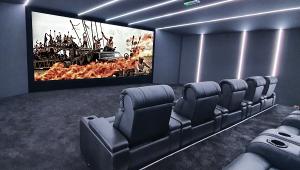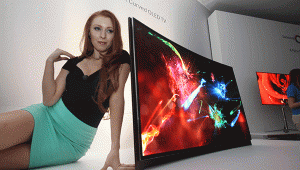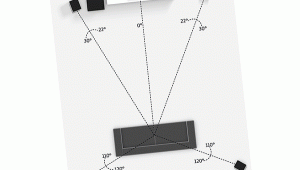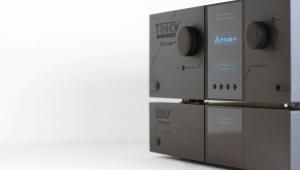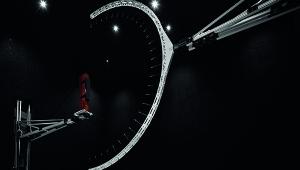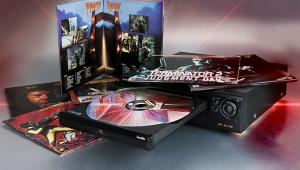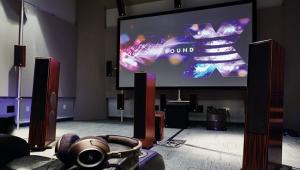System Addicts: From £1k to £1.5m
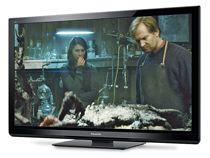
I would expect most buyers to begin with the screen, so that’s where I’m starting. I’ve imposed a top limit of £500, because anything more than that is going to make the rest of the system tricky to complete. And this price immediately throws up some problems. Big displays (TVs above 50in) are off the menu, as are Full HD projectors.
Yet you can still get some good screen real estate for this money.

Browsing online throws up some immediate surprises – for instance, LG’s 42in 42PW450T Active 3D plasma can be found at Currys for just £448. Unfortunately, it’s not Full HD...
What is Full HD, however, is Panasonic’s TX-P42G30B Smart Viera. This is also available from Currys, priced £480. I’m confident this NeoPDP panel can deliver the cinematic images I’m looking for – smooth, detail-rich motion, typically excellent black levels, natural-looking colours – because its bigger, 50in sibling did exactly that when winning a grouptest in a previous
issue. The THX picture preset makes using it foolproof, and
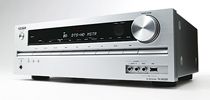 there are plenty of pro-level calibration options should you want to get your fingers dirty.
there are plenty of pro-level calibration options should you want to get your fingers dirty.
Connections include four HDMI jacks (I only want one, of course), an SD card slot (handy for digital camera owners) and a trio of USBs. One of these can timeshift TV from the set’s Freeview HD tuner. This is vital as my budget isn’t going to stretch to a PVR. The Panasonic may not be the last word in style, but I’m not complaining at this price.

With the TV in the bag I’ve got £520 left to secure amplification, speakers and a BD player. While some would run straight to the shelves packed with all-in-one systems (as these combine all three) I’m determined to stick to separates. The reasoning here is simple – it makes upgrading individual components easier at a later date.
Onkyo’s TX-SR309 AV receiver fits my bill perfectly. Available at Richer Sounds for an astonishing £150, it offers 4-in, 1-out HDMI switching (with Audio Return Channel) and five-channel amplification. While you wouldn’t use an entry-level amp such as this to drive high-end floorstanders, it should be more than capable of backing up my preferred speaker array. I’ll confess that I haven’t heard this in action, but have owned and enjoyed its TX-SR308 predecessor.
For speakers I’ve plumped for Boston Acoustics’ SoundWare XS SE. This is a great-looking sub/sat package, mixing a 100W, 8in sub with five smallscale two-way cabinets. We loved the audio
chops of the 2.1 iteration and can’t see why a full-fat array
 won’t be equally impressive. Sevenoaks Sound & Vision will sell you the set for £240.
won’t be equally impressive. Sevenoaks Sound & Vision will sell you the set for £240.
By ruling out an all-in-one system I’ve got to add a standalone Blu-ray deck – and only have £132 in my wallet. Thankfully there are entry-level players that offer an impressive picture performance – certainly up to the demands of the modest-sized television.
The Panasonic plasma isn’t 3D-capable, so I don’t need the player to do 3D, either. To be honest, I don’t need to it to do anything but play Blu-rays and DVDs, but my chosen deck – Sony’s BDP-S185 (£90 direct from Sony) – even comes with VOD access and file playback from USB. These add another level of Smart interaction beyond the Panasonic screen’s own talents.
Done and dusted
So, a 42in HDTV, 5.1 speakers, AVR and BD deck for a combined total of £960 – and I can upgrade any of these components at a later date without worrying about the others. All I have to do now is spend my last £40 on some Blu-rays.
£3,000 3D System – built by Danny Philips
 Building a home cinema system with a £3,000 budget gives you a bit of financial breathing space. You can stop skimping on extras and start thinking bigger and better.
Building a home cinema system with a £3,000 budget gives you a bit of financial breathing space. You can stop skimping on extras and start thinking bigger and better.
And for starters that budget makes it easier to get a 3DTV, which is my main aim. 3D is at its very best on a bigger screen, so I’m not looking any smaller than 50in. In fact I’m not looking any further than Panasonic’s plasmas, which have consistently proved they’re the sets to beat when it comes to enthusiast-grade 3D pictures.
I’ve plumped for the TX-50VT30B, a 50in 3D-ready plasma set from the same series as the monster-sized HCC award-winning TX-P65VT30B. This delivers deep, rich 3D images with
 outstanding black level and negligible crosstalk, alongside fluid movement courtesy of Intelligent Frame Creation. You also get DLNA, Viera Connect, four HDMIs and picture calibration tools from THX and the ISF into the bargain.
outstanding black level and negligible crosstalk, alongside fluid movement courtesy of Intelligent Frame Creation. You also get DLNA, Viera Connect, four HDMIs and picture calibration tools from THX and the ISF into the bargain.
I found the 50in version for £1,300 at Hi-Spek, a deal too good to pass up. It helps that this year’s VT50 replacements are
breaking ground.
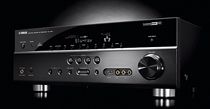 TV done, now for a disc-spinner, and with £1,700 left to play with I can afford to get something a bit special. Naturally it has to be 3D capable, but as a hi-res audio fan I’d also like to something that can spin my small but treasured collection of SACDs and DVD-Audio discs.
TV done, now for a disc-spinner, and with £1,700 left to play with I can afford to get something a bit special. Naturally it has to be 3D capable, but as a hi-res audio fan I’d also like to something that can spin my small but treasured collection of SACDs and DVD-Audio discs.
And as an enthusiast with £3,000 in my pocket, I prize top-quality performance over Smart features – the TV provides those anyway. I want a player with rock-solid build quality, high-grade electronics and wide format compatibility, and that’s why I’m opting for the £500 Cambridge Audio 651BD from
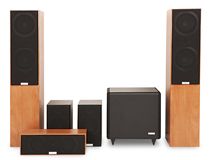 Richer Sounds.
Richer Sounds.
That’s not to say it’s feature-lite. You get two HDMI v1.4 outputs, a coveted Marvell QDEO video processor for DVD upscaling, two USB ports, 7.1-channel analogue outputs, uPnP media streaming and built-in YouTube/Picasa access. Although there’s no built-in Wi-Fi, it can be added with a wireless USB dongle.
In an ideal world I’d have got the step-up 751BD – an outstanding high-end player with an even better spec – but to leave enough cash for my speakers and AV receiver, I’ve had to come to a compromise.
Polished performer
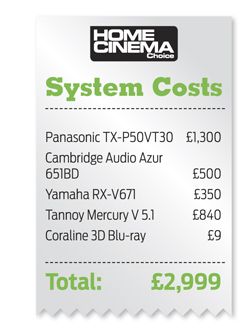 My sound system begins with the Yamaha RX-V671, which I found at Hughes Direct for £350. This seven-channel AVR is a fast, aggressive performer with a polished sound. On the features side, it boasts ‘net radio, streaming services and DLNA. With six HDMI inputs I won’t be left short when my system starts expanding, and crucially they’re all 3D compatible.
My sound system begins with the Yamaha RX-V671, which I found at Hughes Direct for £350. This seven-channel AVR is a fast, aggressive performer with a polished sound. On the features side, it boasts ‘net radio, streaming services and DLNA. With six HDMI inputs I won’t be left short when my system starts expanding, and crucially they’re all 3D compatible.
The Yamaha has more than enough muscle to drive my speakers of choice, the majestic Tannoy Mercury V system. I’m a massive fan of this 5.1 array, which throws in a pair of floorstanding V4 fronts, the VC centre, a pair of V1 standmounts at the back and the dual-driver TS2.10 subwoofer – all for £840 from Hifi4less.
This system commands a movie soundtrack like few others at this price, tearing into action scenes with controlled force and thunderous power. Yet it’s nuanced when needed and the way it shapes high-frequency detail is a thing of beauty. You’re getting a performance you simply wouldn’t expect from a system under £1k. Yes it’s only 5.1, leaving the Yamaha’s surround back channels unused, but I can always add an extra pair of V1s later if the money’s available, or run a stereo zone elsewhere in the house.
That all adds up to £2,990, leaving £10 to spend on a discounted 3D Blu-ray at Play.com to show off my new system – the beautiful Coraline (£8.99 with free delivery) should do the trick…
£10,000 Projection System – built by Steve May
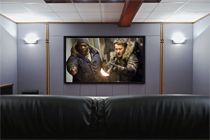 If you read Home Cinema Choice then it’s a fair bet you’ve lusted after the kind of fully-integrated home theatres which seem to be the preserve of the enviably wealthy or Hollywood elite. But it’s possible to enjoy a such an integrated home theatre experience on a budget of just £10k.
If you read Home Cinema Choice then it’s a fair bet you’ve lusted after the kind of fully-integrated home theatres which seem to be the preserve of the enviably wealthy or Hollywood elite. But it’s possible to enjoy a such an integrated home theatre experience on a budget of just £10k.
For the purposes of this exercise, I’m assuming that you already have a building renovation in progress, or that you have existing plans to convert a garage or loft into a living space. That way I can concentrate my costs on the hardware itself.
The objective is a dedicated viewing room, with a monster
 screen and stealthy 7.1 sound system. Unsurprisingly, the lion’s share of the budget will be poured into the bigscreen visuals. While you can project onto a white wall, it’s not something that I’d want to recommend. This is the last place you should cut corners...
screen and stealthy 7.1 sound system. Unsurprisingly, the lion’s share of the budget will be poured into the bigscreen visuals. While you can project onto a white wall, it’s not something that I’d want to recommend. This is the last place you should cut corners...
To save cost and complexity, I’m opting for a fixed screen – the £1,990 90in 16:9 screen RF 90HD from Screen Excellence. This has a smart, velour frame and uses acoustically transparent Enlightor 4K fabric for optimum image quality.
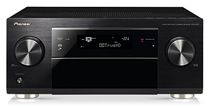 Firing onto this is the Panasonic PT-AT5000 (available for £2,700 from Sevenoaks), a high-performance 3D-capable LCD light cannon capable of stunning HD, and simple to set up.
Firing onto this is the Panasonic PT-AT5000 (available for £2,700 from Sevenoaks), a high-performance 3D-capable LCD light cannon capable of stunning HD, and simple to set up.
For my speaker system, I’ve decided to go in-wall and in-ceiling for a truly professional installation. Making up the front soundstage are a pair of Proficient W850 in-walls (£640), joined by an LM625 Centre (£430). As the screen is acoustically transparent, you can perfectly align this trio for your preferred seating position. For the surround side and rears I’m nominating four Proficient W670s (£620). All seven speakers are
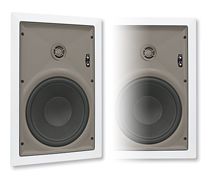 timbre matched for perfect balance and panning.
timbre matched for perfect balance and panning.
As I want as little floor-space lost to physical cabinets as possible, my subwoofer needs to be small but potent: enter Velodyne’s remarkable MicroVee (£850, again from Sevenoaks). This 9in cube has a Titanic 1000W powerplant, yet sports a footprint more befitting Alvin and his chipmunks.
Providing both sound and source is Pioneer. The HCC Award-winning VSX-2021 is an AVR tuned for home theatre, beautifully built and generously equipped, with a total of seven HDMI inputs – just the ticket if you’re looking to expand your system later. It’s also often bundled with the cosmetically matching Pioneer BDP-LX55 3D BD deck (I’ve bagged mine from Peter Tyson Audio/Visual for a combi price of £880).
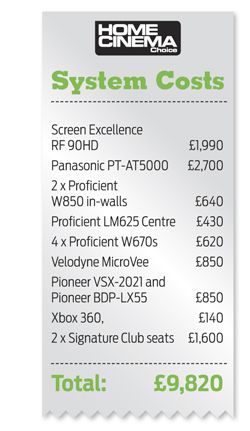
The VSX-2021 combines AirPlay, optional Bluetooth streaming and internet radio with decent network streaming, including WMA, AAC, Ogg, WMA, MP3 and FLAC files. This is handy as my system lacks a Smart TV. It’s positively majestic with multichannel movie soundtracks, too: dialogue clarity is high, while the soundstage is wide, with precise image placement.
The magic touch
For that slick custom-install polish, a great interface is de rigueur. However, while I’d love to add a Crestron or AMX controller it would blow my £10,000 budget. Thankfully, Pioneer provides a neat app to drive its components. The iControl AV2 app for iOS/Android combines a superb graphical interface that shouts touchscreen sophistication. It’s as impressive as heck.
Completing my source line-up is an Xbox 360. Not only is this a solid gold gaming choice (and I want to make the most of my 90in screen), it also brings iPlayer, Netflix and other IPTV services into play. A 4GB console is just £140 – I don’t really need a bigger HDD for my purposes.
So: screen, projector, speakers, AVR and sources – is that the end of the shopping spree? Not quite. This is a setup for a dedicated room, so I need dedicated seating...
That’s why I’ve put aside a fair chunk of my budget for a pair of Signature Club cinema seats (£800 each). These black leather bad boys add that final, comfortable pro touch.
Total cost £9,820 – which leaves enough for interconnects and cables. Sorted!
Lottery Winner’s System – built by Richard Stevenson
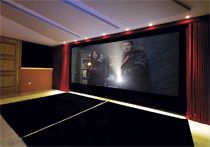 So those EuroMillions lottery numbers have come up – time to get yourself a very serious setup. Assuming you’ve already purchased a country pile with a large dedicated room, the options available when money is really no object are extensive. So, to keep things simple, I’ve set myself a target budget of £1.5m.
So those EuroMillions lottery numbers have come up – time to get yourself a very serious setup. Assuming you’ve already purchased a country pile with a large dedicated room, the options available when money is really no object are extensive. So, to keep things simple, I’ve set myself a target budget of £1.5m.
For serious bigscreen viewing the semi-professional Runco D-113d would be my projector of choice, at around £200,000 including installation and calibration. Effectively two PJs on top of each other, this industrial-looking beast uses Runco’s Constant Stereoscopic Video (CVS) platform to ensure a near professional-standard 3D performance in the home. You can assume its 2D images are pretty spiffy, too.
 As my colleague Steve May has already stated, your projector performance is only as good as the screen – going for a white Ikea bed sheet pinned to the wall is a no-no. I’ve opted for a Screen Research Reference X-Mask TheatreCurve, at 200in, with motorised masking. At approx £25,000 with custom fit and finishes, this curved screen eliminates optical distortion at the edges and is purpose-built to your requirements.
As my colleague Steve May has already stated, your projector performance is only as good as the screen – going for a white Ikea bed sheet pinned to the wall is a no-no. I’ve opted for a Screen Research Reference X-Mask TheatreCurve, at 200in, with motorised masking. At approx £25,000 with custom fit and finishes, this curved screen eliminates optical distortion at the edges and is purpose-built to your requirements.
For a stunning source component I reckon you won’t go far wrong with the visually spectacular Goldmund Eidos Reference Blue Limited Edition Blu-ray player. The £120,000 ticket gets you floating magnetic-levitation damping and bonkers audiophile components. Video performance is top-notch as well, but probably shares much of the same tech as a £500 deck – don’t mention that when showing it off to your mates.
 Blowing my budget
Blowing my budget
On to the audio side – and this is where my £1.5m budget begins to look a bit small.
There’s no shortage of ultra-high-end AV processor esoterica out there, but when it comes to decoding those all important multichannel mixes I would go with one of the most respected names in the business, Krell. The US brand’s £35,000 Evolution 707 is an incredible feat of engineering with a lush design. Fully featured and flexible, it can be configured for 8.4-channel output using twin centre-channel speakers and four subwoofers.
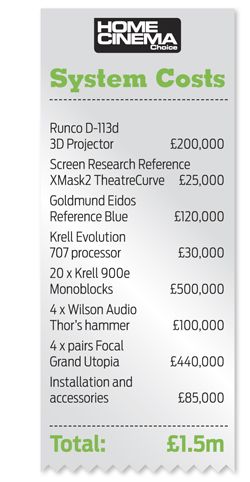
Okay, height/width channels would have been nice, but you can’t have everything even with £1.5m. And the speakers I have my eye on can’t be hung form the ceiling...
It would be churlish not to stick with Krell for power and the brand’s flagship £25,000 Evolution 900e Monoblock amp fits the bill. Delivering close to 1.5kW into my chosen speakers’ 5ohm load, it offers a huge sound and wonderfully detailed amplification. One 900e for each of the eight channels would be the minimum but I want the ultimate performance, so I’m going to bi-amp every speaker. That’s 16 power amps at a total cost of £400,000.
Combining technology, innovative materials and eye-watering looks, my speaker of choice is Focal’s epic, awe-inspiring Grand Utopia. These enormous cabinets feature Focal’s top-spec Beryllium tweeter and electromagnetic woofer to deliver a scale and presence second to none. In keeping with a performance-first philosophy I’m sticking to identical speakers for all eight channels. That’s £440,000 gone, then.
For seismic LFE to match the Focals I’ve set aside £100,000 – just enough to get a quartet of Wilson Audio Thor’s Hammer subs. These are the size of wardrobes and pack twin 15in drivers, but are passive, so I need four more power Krell amps to drive them. If you have space, a potentially more dramatic option would be to use Velodyne DD18+ subwoofers for all four subwoofer channels and as ultra-deep bass for each of the main eight channels, too. That would involve using 12 of the £6,000 woofers – still more affordable than the Wilson/Krell combo.
With the kit list nudging over £1.4m I’m using the last £85,000 for high-class motorised home cinema seating, top-spec cables, pro installation and a Hinari popcorn maker.
This article first appeared in the June 2012 issue of Home Cinema Choice
 |
Home Cinema Choice #351 is on sale now, featuring: Samsung S95D flagship OLED TV; Ascendo loudspeakers; Pioneer VSA-LX805 AV receiver; UST projector roundup; 2024’s summer movies; Conan 4K; and more
|



